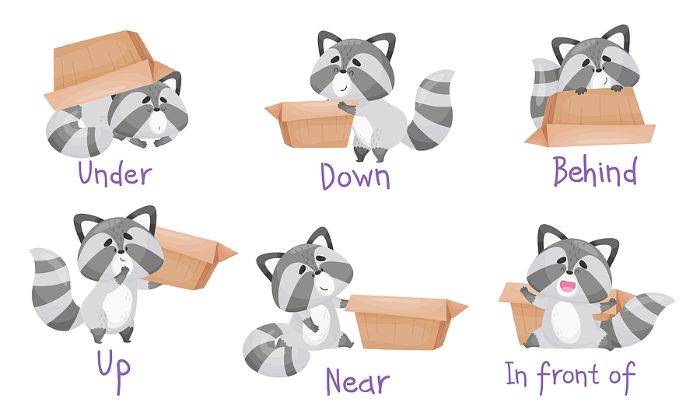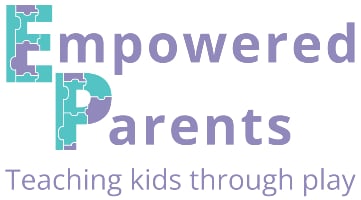Here are some fun ways to teach your children positional language in a way they will remember.
What is Positional Language?
Positional language, or prepositions, describes where things are in relation to others.
Teaching your children these positional words through games helps develop visual perception, cognitive skills, and early maths and geography understanding.
Examples of Positional Language
Some prepositions, such as “for” or “since,” are rather abstract concepts for young children, so it’s best to use language games and activities to teach prepositions of place first.
These types of positional language words are easy to illustrate with hands-on examples:
- above
- before
- behind
- below
- beneath
- beside
- between
- by
- close (to)
- down
- far (from)
- in
- inside
- near
- next to
- off
- on
- outside
- over
- through
- under
- up
- with
While worksheets can help teach positional words, hands-on activities are far more effective for preschoolers.
Children learn best through physical experiences—such as placing an object on a chair or sitting on it themselves—making games and practical activities the most meaningful way to teach positional vocabulary.

12 Fun Positional Language Activities and Games
Positional language can be taught through many different types of experiences. Here are some ideas for positional language games, activities, songs and fingerplays.
1. Hide the Teddy Bear
Hide a teddy bear or other favourite toy somewhere in the room. Ask the children to look for it.
When they find the toy, they must explain using positional language where they found it, such as “under the table.” Children can take turns hiding the bear.
This game may also be played in reverse, with you stating aloud or showing a task card with a chosen positional word. Children must then follow the direction to place the teddy bear accordingly.

2. Barrier Drawing Game
In barrier games, children sit on the floor or at a table with some type of barrier between them so they cannot see each other’s papers or drawings.
Part of the drawings may already exist, such as an image of a snowman. You can also ask the children to each draw a snowman, to encourage their creativity.
To build background, begin with sharing a picture book that includes a snowman.
Then name various objects and where they should be placed, such as, “please draw a hat next to the snowman.” Kids must follow directions and add a hat to their drawings in the correct position.
Children can also take turns giving directions for drawing objects in specific positions within the pictures. At the end, remove the barrier so children can compare drawings.
3. Sally Says
This is another version of Simon Says, which avoids the aspect of players not doing something because Simon did not say to do so.
“Sally,” or the current leader’s name, gives the other players movement directions that include positional words. “Sally says put your hand on your head,” for example.
Include “left” and “right” to make it more challenging. Children take turns playing the part of the leader.
4. Grover Around
Share this vintage Sesame Street music video Grover Around with kids.
With the help of a fun song and a set of swinging doors, lovable Grover works very hard to make sure young viewers understand positional language words, “over,” “around,” “under,” and “through.”
5. In On Under Song
Join the English Vitamin Bubbles to encourage learning with music. Through animation, children learn a catchy tune and practise the positional words “in,” “on,” and “under.”
The words appear in print on the screen, adding another dimension to the experience.
6. Five Little Ducks
A preschool favourite, the animated version of Five Little Ducks reinforces the positional words “over” and “far.” As a bonus, children also practise counting 1-5, forwards and backwards.
7. Snips from Magazines and Catalogs
Provide saved magazines and catalogues for the children to cut. Ask them to snip out pictures of specific things, such as a toy, snack, person, pet and furniture.
Give them each an illustrated background sheet to colour, possibly picturing a room, or have them each draw their own pictures of rooms. Then, direct them to glue their objects in specific positions: “Please stick your toy on the floor,” for example.
8. It’s in the Book!
Many picture books contain aspects related to positional words. You can find many lists of these books online.
One such book is A Parade of Elephants by Kevin Henkes. Any book you find that contains a focus on at least a few positional language words can work, however.
Make copies of a rather plain page from your chosen book for scenery and a sense of place. Design and copy a page of characters or objects based on your book for the children to cut.
Either ask them to glue the pieces in positions described in the story, or direct them to place the cut objects or characters in specific positions you choose.
For example, to go along with A Parade of Elephants, give kids a sheet with five elephants to colour, cut, and stick in stated positions (up, down, over, under, in, and out) on a background.
Here’s a video of Kevin Henkes reading his book:
9. Where’s the Worm?
From your paper scraps box, retrieve multiple colours for paper apples and rainbow worms of target colours. Model for your kids how to cut a large apple and smaller, multi-coloured worms.
Instruct them to glue the apples near the centre of large sheets of paper. Then ask them to stick the “red worm above the apple,” for instance, following suit with all the other worms.

10. Eensy Weensy Spider
Teach your kids about “up” and “down” with this cute finger play based on a modern nursery rhyme. Alternative versions may use “itsy bitsy” or “incy wincy,” but the positional words remain the same. Here are the words and directions if you choose not to use the video:
The eensy weensy spider
Climbed up the water spout. (Crawl fingers up)
Down came the rain (Wiggle fingers down)
And washed the spider out. (Brush hands to side)
Out came the sun (Circle arms above head)
And dried up all the rain.
And the eensy weensy spider (Crawl fingers up again)
Climbed up the spout again.
11. Wiggle Worms
Children use fingers or short strips of brown yarn for the “worms.” This fingerplay contains many positional language words and is great for reinforcing the concept of rhyme, as well.
Wiggle your worms up, then wiggle them down.
Wiggle your worms around and around.
Wiggle them high, wiggle them low.
Wiggle them fast, wiggle them slow.
Wiggle them over the tops of your toes.
Wiggle them under the tip of your nose.
Wiggle them up your arm to the top
Wiggle them down to your fingers and stop.
Wiggle your worm ‘cross the top of your head,
Then put your worm back in his own little bed.
by Jean Warren
12. This is My Turtle
Here is a simple finger play for youngsters to practise “in” and “out.” Children are often intrigued by turtles, and sharing a picture book about these reptiles is a fun addition.
This is my turtle.
(Make a fist, extend thumb)
He lives in a shell.
(Hide thumb in fist)
He likes his home very well.
He pokes his head out when he wants to eat.
(Poke thumb out of fist)
And pulls it back in when he wants to sleep.
(Pull thumb back into a fist)
You can find books about fingerplays at the library, such as Hand Rhymes by Marc Brown, or try some of these fingerplays too.
Consider the activities you normally do during a day with preschoolers. There are many natural opportunities to reinforce positional language, such as waiting in line, tidying up, playing outdoors, and simply having fun!


Lena
Friday 20th of October 2023
It’s time to know it in details.Thank you!